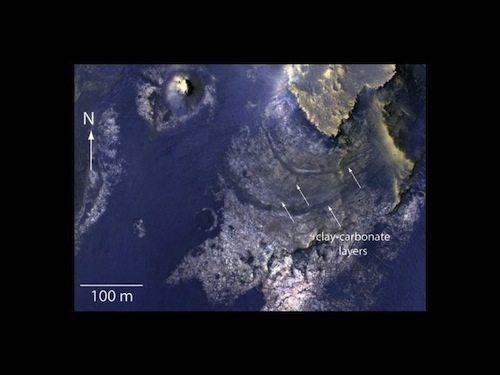 Intelligent Design
Intelligent Design
 Life Sciences
Life Sciences
 Physics, Earth & Space
Physics, Earth & Space
Magical Thinking in Science Journalism

See if you can follow the logic here. The Telegraph headline says “‘Strongest evidence yet to there being life on Mars.’” The subhead: “Martian rocks from a crater hit by a meteorite may contain the strongest evidence yet that there is life on Mars.”
New evidence of Martian life? The reference is to a freshly published journal article in Nature Geoscience, “Groundwater activity on Mars and implications for a deep biosphere,” speculating on the tantalizing possibility that traces of past groundwater upswelling in Mars’ McLaughlin Crater might conceal indications of subsurface life — as complex as fungi:
McLaughlin Crater, one of the deepest craters on Mars, contains evidence for Mg-Fe-bearing clays and carbonates that probably formed in an alkaline, groundwater-fed lacustrine setting. This environment strongly contrasts with the acidic, water-limited environments implied by the presence of sulphate deposits that have previously been suggested to form owing to groundwater upwelling. Deposits formed as a result of groundwater upwelling on Mars, such as those in McLaughlin Crater, could preserve critical evidence of a deep biosphere on Mars. We suggest that groundwater upwelling on Mars may have occurred sporadically on local scales, rather than at regional or global scales.
The Telegraph elaborates in an interview with one of the authors of the study, John Parnell:
Speaking from his laboratory at the University of Aberdeen, geochemist Prof Parnell said: “We could be so close to discovering if there is, or was, life on Mars.
“We know from studies that a substantial proportion of all life on Earth is also in the subsurface and by studying the McLaughlin Crater we can see similar conditions beneath the surface of Mars thanks to observations on the rocks brought up by the meteorite strike.
“There can be no life on the surface of Mars because it is bathed in radiation and it’s completely frozen. However, life in the sub surface would be protected from that.
“And there is no reason why there isn’t bacteria or other microbes that were or still are living in the small cracks well below the surface of Mars.
“One of the other things we have discussed in our paper is that this bacteria could be living off hydrogen, which is exactly the same as what microbes beneath the surface of the Earth are doing too.”
If there is or ever was such subsurface life, then it makes sense to look for it at McLaughlin Crater. This realization might bring us a step closer to finding evidence of a Martian biosphere — if Mars ever had life. If Mars never did have life, because generating life is devilishly difficult without the direction supplied by intelligent design, then Dr. Parnell’s idea would not bring us any closer to finding life in the Martian subsurface, whether complex or otherwise.
I understand that Parnell and his colleagues want to draw attention to their work, and they hope it offers a roadmap for future exploration of the Martian landscape. Nor did they write the headline, though it appears between quote marks implying that it was said by someone in a position to know. I also understand that Telegraph editors want to stir up reader interest.
But the idea that thinking a thought and wishing a wish — “Oh, let’s look in the Martian subsurface!” — itself somehow constitutes “evidence” of life on Mars is obviously magical thinking. It’s the notion that because we may have a clever idea of where to search, that fact increases the odds that there is something out there to search for, waiting for us to find it.
If you have little kids, you’ll also recognize this logic, which comes naturally to small children and might most charitably be called wishful thinking. It’s endemic in both reporting and research about life elsewhere, in which inhabited worlds are regularly conjured with no more than words.
Image: Layers with Carbonate Content Inside McLaughlin Crater on Mars, NASA/JPL-Caltech/Univ. of Arizona.
